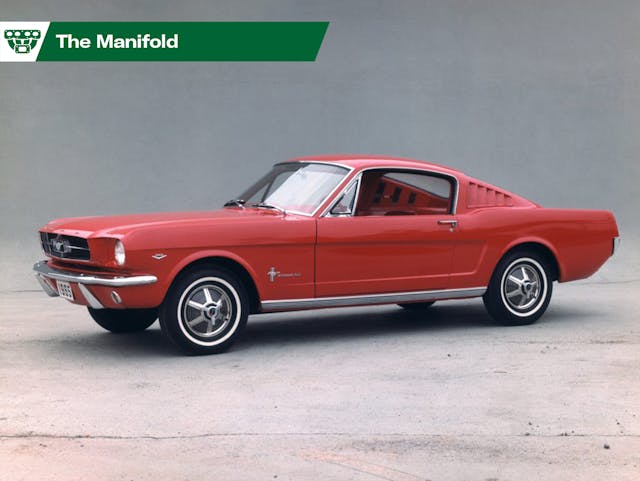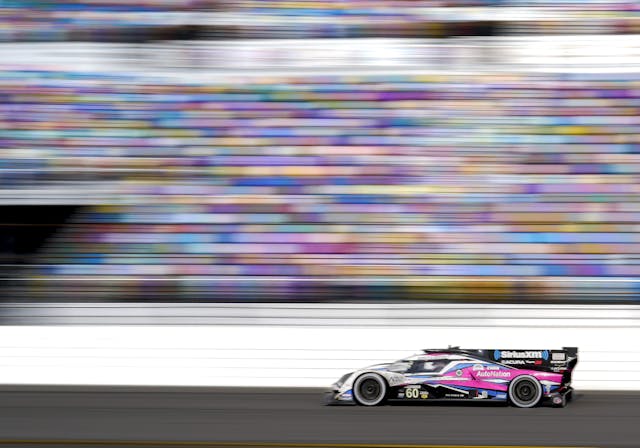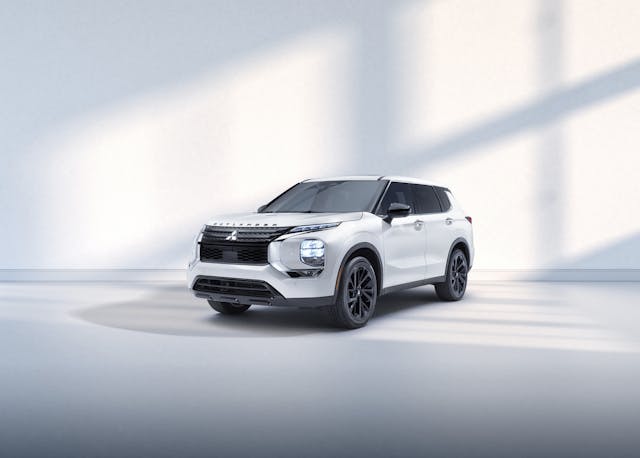Cable-free AC for early Mustangs, GM workers offered buyout, McLaren’s first hybrid supercar turns 10

Vintage Air gives the 1964.5–66 Mustang cable-free climate control
Intake: Vintage Air released a new heating and air conditioning system for the first two years of the first generation Mustang (or 2.5 years, because the Mustang’s first generation technically spans from 1964.5–1966) sporting their fifth generation of HVAC technology. They claim the quality is on par with the latest from the automakers, highlighting a microprocessor-controlled system that eliminates vacuum lines and cable actuation. But just as before, all of Vintage Air’s upgrades are behind the scenes, even the factory in-dash three-lever control panel can be used with this retrofit.
Exhaust: Vintage Air has been at the forefront of HVAC upgrades for classic cars, to the point they were trusted to make the system installed in the 2005–06 Ford GT supercar. The factory-like fitting ensures owners associate the Vintage Air brand as they would a GM Performance crate motor, Wilwood brakes, or an Art Morrison frame. But it’s even nicer to see they aren’t resting on their laurels, instead, they are making cables and vacuum lines a thing of the past. — Sajeev Mehta

Rolex 24-winning Acura penalized for tire pressure infringement

Intake: This is what I wrote on January 30 about the Meyer-Shank Racing’s Acura after its victory in the 2023 Rolex 24 at Daytona: ”The major marvel of the race was the Meyer Shank Acura, which was able to better launch off the corners than the competition. All race long, the pole-sitting Acura seemed to be able to pass the competition at will.” Now we know how why: They were cheating. Before each race begins, Michelin and IMSA set a minimum tire pressure that is good for safety and longevity. Lower the tire pressure from that and the car may perform better. Apparently, Meyer Shank engineered a way to make the tire pressures look higher on the telemetry, while actually running lower pressures on the cars.
Exhaust: The discovery was made by Honda Performance Development, and passed on to IMSA, which launched an investigation. Meyer-Shank was allowed to keep the win, the Rolex watches and the trophy, but was penalized 200 of its 350 WeatherTech Championship points, plus all points from the Michelin Endurance Cup, plus the loss of race prize money. They were also fined $50,000. Additionally, a team race engineer had to turn over his IMSA credential and was placed on indefinite suspension. Too light? Maybe. But it’s clear IMSA takes this sort of rule-circumventing seriously. — Steven Cole Smith
Nissan Ariyas recalled for loose steering wheel

Intake: The National Highway Traffic Safety Administration (NHTSA) is calling for a recall of 1063 electric Nissan Ariyas over an issue involving a loose steering wheel that, in two cases, came off. This follows by a day a similar recall for some Tesla models for the same reason. In the case of the Nissans, both the affected vehicles had an “end-of-line repair” that required removing and re-installing the steering wheel, which apparently was done improperly.
Exhaust: According to NHTSA’s letter to owners, “A steering wheel with a loose or missing bolt can detach from the steering column, causing a loss of steering control, increasing the risk of a crash. Remedy: Owners are advised to contact their dealer for transport and immediate repair if the steering wheel feels loose when gently rocking the wheel forward and back with their hands. Dealers will replace the steering wheel bolt, free of charge.” —SCS
GM offering buyouts to most U.S.-based salaried workers

Intake: Associated Press is reporting that General Motors “is offering buyouts to most of its U.S.-based salaried workforce and some global executives in an effort to trim costs as it makes the transition to electric vehicles.” GM has about 58,000 salaried workers, and the buyouts should help the company meet its goal of $2 billion in cost cuts by the end of 2024. The company says the offers also are designed to avoid any possible firings at a later date. CEO Mary Barra told analysts in January that GM wasn’t planning for any layoffs.
Exhaust: According to AP, offers will go to white-collar workers with at least five years of service, and global executives who have been with the company for at least two years. On the bright side, it could free up some good executives for careers with start-ups that need workers with a solid automotive background. — SCS
On this day in 2013, the McLaren P1 lit up Geneva

Intake: Ten years ago the mighty McLaren P1 was unveiled at the Geneva International Motor Show. Conceived by McLaren to be “the best driver’s car in the world on both road and track,” it would become one of the so-called Holy Trinity of hybrid hypercars, alongside the Porsche 918 Spyder and LaFerrari. In McLaren’s case, the car’s 747-hp 3.8-liter twin-turbo M838TQ V-8 engine was enhanced with an electric motor adding a further 179 hp for a grand total of 903 horsepower—and all of it was sent to the rear wheels. The $1.3M P1 would reach 62 mph from rest in 2.8 seconds, hit 124 mph in 6.8, and 186 mph in 16.5, which was a full five seconds faster than the McLaren F1. Designed around a carbon MonoCage structure fitted with carbon body panels, McLaren was on a mission to minimize mass, so there was no carpet inside, the glass was just a tenth of an inch thick in places, and the exhaust was made from Inconel. The P1 featured active aerodynamics, including a Formula 1-style DRS system, adjustable suspension, and was fitted with carbon ceramic disc brakes that could halt the car from 62 mph in less than 100 feet. McLaren says the P1 was driven more than 385,000 miles during its test program, but the 375 examples that were sold out immediately have probably not got anywhere close to that mileage, even if you added them all together.
Exhaust: The P1 hasn’t turned out to be quite the investor vehicle that its F1 predecessor became, as in a decade the P1’s value has increased by around half a million dollars, according to Hagerty’s valuation experts. What’s more, it’s taken only those ten years for the P1’s performance to be matched by the Artura for less than a quarter of the price. Still, on the 10th birthday of this landmark car, we tip our hats to the mad folks from Woking. — Nik Berg
Mitsubishi pumps more than $10 billion into EVs and hybrids

Intake: Remember Mitsubishi Motors? The company that once produced fan favorites such as the Lancer Evolution, the Montero, and the Eclipse (the car, not that crossover thing) has faded from popularity recently, but according to a new report from Automotive News, Mitsubishi is looking to rebound in a big way as the world turns an eye to an electric future. The Japanese automaker announced that it will pour more than $10 billion into electrified vehicles and battery production in the coming years. It’s aiming for key markets like North America and plans to lean on help from Nissan and Renault to make quick strides. The new corporate roadmap, unveiled by CEO Takao Kato this morning, includes several electrification targets aimed at the turn of the decade, but it also included more immediate milestones such as 1.1 million global sales by the end of the 2026 fiscal year. That’s a hefty increase from this year, in which the company expects global sales to reach just 866,000 units. The investment will precipitate nine new electrified models—a mix of pure EVs, hybrids, and plug-in hybrids—over the next five years. Among the electrified vehicles previewed during the announcement were a full-electric truck, a two-row electric SUV, and more.
Exhaust: That 1.1-million-unit goal still doesn’t build back to Mitsubishi Motor Corp.’s pre-pandemic worldwide volume of 1.127 million vehicles, but it’s a step in the right direction. We’d love to see a smaller electric truck here in the states. It could potentially use some of the underpinnings from Nissan for the project, should that automaker follow through with what dealers have been asking for, as we reported earlier this year. — Nathan Petroelje


So is Meyer-Shank Racing’s Acura the automotive equivalent of “Brady’s Balls”?
GM is getting rid of it’s “overhead” in the form of salaried workers. Do they not see a bright prosperous EV future in our booming economy? Sarcasm aside I am sure GM has tons of bloat in it’s corporate structures but this to me is another canary in the economic coal mine. Things are not as rosy as our liars/politicians tell us.
I wish no ill will here to any persons or company, but I think GM employees may find it harder to find a spot with the start-ups than one might expect. From what I see, most start-ups (excluding Tesla) are either in financial trouble or soon will be. The start-up offerings are beyond, sometimes way beyond, median car prices and that market is not that big. Meeting what demand they do have is hampered by supply chain issues. Further, I suspect the affluent person spending over $100,000 on an EV would be looking for an established name like Mercedes, Bentley, or Rolls-Royce and not a company that may not be around tomorrow.
Automotive history is clear. Since World War II, starting up a new car comapny is really hard and capital intensive. (See “Kaiser-Frasier: The Last Onslaught on Detroit”.)
I think Tesla had a few start-up advantages by being the only game in town, appealing to wealthy investors, and being able to sell MPG credits to other car companies. Looking at Tesla now, the automitive press is seeing models that are quite old and quality still not up to the price point. Tesla is getting real competition from established makes (as I knew it would) with newer vehicles and a broader selection. The Tesla stock price crash is just a reflection of this reality.
I’m thinking the racing team should have had to forfeit the win. If that, combined with the other punishments, would be too harsh, then lighten up the fine or whatever. But the loss of the win, trophy and prize money should have been the first, absolute punishments. That, and revoking the credential of the mastermind of the cheat.
Kudos to Honda Performance Development for being on the up-and-up. Less ethical people could have pretended they never saw it.
60 years later I can still buy a cable for my heater control, which still works fine. Will I be able to buy control board for that upgraded system even 10 years from now due well 60 years? What’s wrong with just common sense and kiss. “keep it simple stupid “
I agree. However, to the current and younger generations, cables aren’t cool. 😥
If they took the Acura team cheating seriously, the win would have been vacated as their cheating CLEARLY didn’t just contribute to the win, it was the sole reason
Considering the obscene prices that are being charged for the 4 wheel, disposable appliances that are EVs, you would think that GM, and any other car company making EVs, would be rolling in the proverbial cash to cover all the middle management positions. Especially considering that governments are bent on forcing these on people as opposed to letting the market decide. I just hope that no more bailouts are given to any company in any industry, let alone ones that could/will fail due to misguided policies. Companies do have the ability to fight back.
Let the business trained and industry-involved chime in if they will:
GM of the past few years looks like a company dolling itself up to be sold for the benefit of the elite stockholders, nothing to do with ensuring a future of the company.
-Trimmed back model lines to the point that there is very little product overlap with many other companies (i.e., Honda, VW, etc.) aside from the generic crossover segment.
-Trimmed back to the point that much of what is left is what a purchaser would want to continue (trucks, larger SUV, Corvette…) to augment their own offerings and capitalize on the brand equity in some markets.
-Cutting workforce on mass fits with such a plan
-so much investment in EV stuff to the point they are arguably a leader –so it could be cost-saving for another company to just buy this intellectual property out
^plus longstanding comments from the industry (didn’t Marchionne say over a decade ago?) that we are looking at an upcoming era of corporate consolidation. Stellantis is just a start of this…
Not cheap to go cable-free… I was genuinely curious on the ’67-’68 VA HVAC kit… it’ll be over $2k by the time tax is paid. Vent windows still work, for the time being…